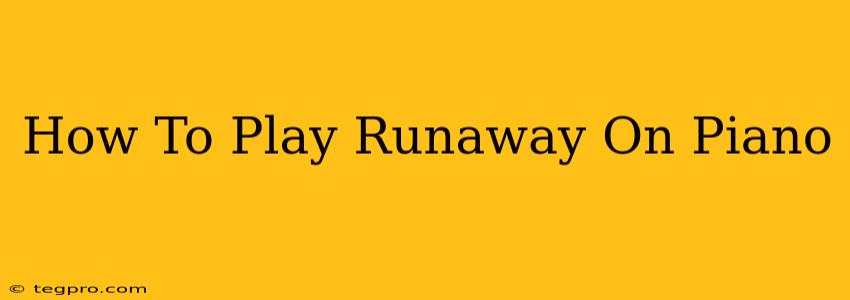Are you a fan of AURORA's hauntingly beautiful "Runaway"? Do you dream of playing this enchanting melody on the piano? This guide will walk you through learning to play "Runaway" on piano, even if you're a complete beginner. We'll break down the process into manageable steps, focusing on the essential chords and melody.
Understanding the Song's Structure
Before diving into the notes, let's understand the basic structure of "Runaway." The song primarily uses simple, repetitive chords and a memorable melody. This makes it an excellent choice for aspiring pianists. The song's structure is fairly straightforward, mostly based around a verse-chorus pattern. Mastering these core elements will allow you to play along to the recording or even improvise your own variations.
Essential Chords for "Runaway"
The beauty of "Runaway" lies in its simplicity. The song primarily utilizes these three chords:
- C Major: This is a bright, cheerful chord that forms the foundation of many sections.
- G Major: This adds a touch of warmth and progression.
- Am (A minor): This chord provides a contrasting, slightly melancholic feel, adding depth to the song's emotion.
Learning the Chord Shapes
Familiarize yourself with the finger positions for each chord. There are numerous variations depending on your hand size and comfort, so experiment to find what works best for you. Numerous online resources and piano tutorials demonstrate different voicings of these chords.
Mastering the Melody
The melody of "Runaway" is equally accessible. It's characterized by its gentle, flowing lines and memorable motifs. You can find sheet music for "Runaway" online through various sources. Start slowly, focusing on accuracy and rhythm before increasing your tempo.
Breaking Down the Melody
Practice the melody in sections. Don't try to learn the entire piece at once. Begin with the first few bars, mastering them before moving on to the next. This approach prevents frustration and ensures you build a strong foundation.
Putting it All Together: Playing the Full Song
Once you've become comfortable with the individual chords and the melody, it's time to combine them. Practice playing the chords alongside the melody, paying close attention to the rhythm and dynamics.
Tips for Success
- Practice Regularly: Consistent practice, even for short periods, is more effective than infrequent long sessions.
- Listen Actively: Pay close attention to the nuances of AURORA's performance to understand the song's phrasing and emotion.
- Use a Metronome: This will help you develop a steady rhythm and improve timing.
- Record Yourself: Listening back to your playing can help identify areas for improvement.
- Don't Be Afraid to Experiment: Once you’ve mastered the basics, feel free to experiment with different voicings and interpretations.
Beyond the Basics: Adding Nuance and Expression
As you become more proficient, you can add layers of nuance and expression to your performance. This might include:
- Dynamics: Varying the volume to emphasize certain phrases.
- Pedaling: Using the sustain pedal to create a richer, more resonant sound.
- Articulation: Controlling the release of notes to create different textures.
Learning to play "Runaway" on piano is a rewarding journey. With patience, practice, and a willingness to learn, you'll be able to play this beautiful song and impress your friends and family. Remember to enjoy the process! Happy playing!

